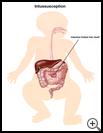
Intussusception
________________________________________________________________________
KEY POINTS
- Intussusception is when one part of the intestine folds into itself, like the way a telescope folds. This can put pressure on the intestine and block food from passing through. Intussusception is an emergency.
- The most common treatment is an air or fluid enema through your child's rectum to help unfold the walls of the intestine. Your child may need to be in the hospital.
- Ask your provider how long it will take your child to recover and how to take care of your child at home.
________________________________________________________________________
What is intussusception?
Intussusception is when one part of the intestine folds into itself, like the way a telescope folds. This can put pressure on the intestine and block food from passing through. Intussusception is an emergency. If it is not treated right away, it can cause part of the intestine to die or develop a tear. This can result in a dangerous infection inside the belly called peritonitis.
Intussusception is most common in children between 3 months and 5 years of age, but it can happen at any age.
What is the cause?
The exact cause of intussusception is not known. It sometimes happens when a child has a cold or other viral illness that causes swollen glands in the belly. Swelling in the wall of the intestine can cause the intestine to fold into itself.
What are the symptoms?
Most children with intussusception have sudden and severe belly pain. The pain comes and goes in waves. The waves last seconds to minutes and may happen every 5 to 15 minutes. During these painful attacks your child may whimper, cry, or scream. Infants may draw their legs up to their belly, while toddlers may freeze in the middle of whatever they were doing. Other symptoms may include:
- Vomiting especially if it turns yellow in color
- Blood in bowel movements that may look like red jelly
- Spells of pale skin, especially in the face
- Feeling unusually tired
How is it diagnosed?
Your child’s healthcare provider will ask your child's symptoms and medical history and examine your child. Tests may include:
- X-rays, which show pictures of the inside of your child's belly
- An ultrasound, which uses sound waves to show pictures of your child's belly
- A contrast enema, which is an X-ray taken of the belly after fluid or air is inserted through the rectum to show the walls of the intestine and any possible problems. The fluid can help the intestines show up well on the X-ray. This test may also treat the problem.
How is it treated?
Your child may be treated in the emergency department or in the hospital.
The most common treatment is the air or fluid enema that is also done to diagnose the problem. Gently putting air or fluid through your child's rectum helps unfold the walls of the intestine. This treatment is very effective in children. In rare cases, your child may need surgery if the enema does not work, or it cannot be done because your child's intestine is already torn.
How can I take care of my child?
Follow the full course of treatment prescribed by your child’s healthcare provider. Ask your provider:
- How and when you will get your child’s test results
- How long it will take your child to recover
- If there are activities your child should avoid
- How to take care of your child at home
- What symptoms or problems you should watch for and what to do if your child has them
Make sure you know when you should bring your child back for a checkup. Keep all appointments for provider visits or tests.
Last modified: 2017-01-13
Last reviewed: 2018-10-19

